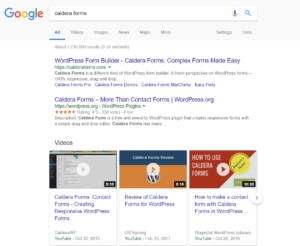Two things are true about my life: my business partner and I own a popular web form product, and 50% of our product website’s traffic comes from search engines.
This means that I think about forms and SEO a lot. However, most of us don’t think about these two things together often. This is fair: after all, most of your SEO efforts will come from a quality content strategy and lots and lots of networking (don’t know what I mean? Learn about link building here).
However, there are two important considerations when thinking about implementing a form and making sure that your site is doing its best to be a part of a search result. So, after you’ve covered all of your SEO basics, such as identifying your keyword opportunities, looking at your on-page and off-page SEO, and more, make sure you give some thought to what your forms are doing.
(A quick tip: we are big fans of Pathfinder SEO at Caldera Forms. Their approach to self-guided SEO is something that we can easily implement, it’s cost-effective and it actually makes a difference in how we rank and how we continually work to make our site a site that makes Google happy).
Pitfall #1: Is Your Form Preventing Site Crawling From Happening The Right Way?
Caldera Forms is often used for complex web applications. We’ve seen our form product get used in many different ways that ask questions of users to drive a result. For example, we have seen Caldera Forms-powered lifestyle quizzes that then recommend a diet plan, Caldera Forms-powered membership sites that give you an application form to fill out and then give you access to members-only content, and more.
These uses are great, but sometimes, a less-than-great side effect arises: the form-based app hides keyword-rich content. This can happen, at its simplest level, if a form needs to be filled out before keyword-rich content appears on the page. Since the search engines crawling your site won’t take your survey, the resulting paragraphs with great content may never be indexed, and therefore not appear in search results.
 Thankfully, this problem has a quick solution: put your content in multiple places. You can have valuable content as part of an application that engages your users while also including it in more crawlable places on your site, such as documentation or blog posts. This is also a way to work smart: it means the content you’re creating is working twice as much.
Thankfully, this problem has a quick solution: put your content in multiple places. You can have valuable content as part of an application that engages your users while also including it in more crawlable places on your site, such as documentation or blog posts. This is also a way to work smart: it means the content you’re creating is working twice as much.
If content is what you sell, it can be a little off-putting to be told to make your restricted content available freely elsewhere. This is not what we’re suggesting – your work and content have value, and you should maintain it.
But in this instance, I would make sure that your previews, product pages, and other pages that you use to convince potential customers also targets the keywords that hide beneath the forms. Remember, the motto of all content marketing is:
“You could do this yourself, or you could hire me to do it for you.”
Pitfall #2: Is Your Smart Downloadable Strategy Hiding Gold From Search Engines?
Another form we commonly see is the form that collects information in exchange for a downloadable file. What that means is that a lot of people online are using a very smart customer engagement strategy: they put together a valuable resource such as an ebook, a worksheet, or a template, and they give it away for free in exchange for an email address.
This is great. It makes the internet more valuable, while also showing off your expertise and convincing your potential customers that you’re the place to go when they’re ready to buy. However, you should make sure that this intelligent content marketing strategy does not hide away valuable content from search engines.
If you have great content hiding behind a downloadable, don’t despair! The solution to this common pitfall is the same as above: simply reuse the content. Much like in the example of the professional content creator, you don’t want to give away the valuable thing that you’re exchanging for a lead. However, you can capitalize on the search volume on topics of interest related to your business by including content snippets on your site’s pages.
For example, on the page where you collect an email address in exchange for an ebook, you can include an Amazon-style book summary, excerpt, and review that incorporate the keywords that you’re hoping to target.
Another clever thing you can do is create a simple infographic and make sure that you optimize that image for search engines. Extra points if the infographic can easily be shared on Twitter or Pinterest.
A Bonus Tip: Google Cache
 A final tip: you can see cached versions of your site in regular Google searches so that you can see the difference between how a search engine processes your site and how a human might. This can be a great way to discover places in which you can reuse already existing content to make search engines work even harder for you.
A final tip: you can see cached versions of your site in regular Google searches so that you can see the difference between how a search engine processes your site and how a human might. This can be a great way to discover places in which you can reuse already existing content to make search engines work even harder for you.
Were these tips useful? Are there other pitfalls related to forms and SEO that you think people should be aware of? Tell us on Twitter (@CalderaWP). And if you haven’t yet tried out Caldera Forms, check us out – it’s free to download on WordPress.org.
